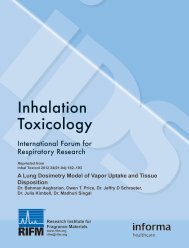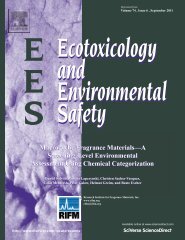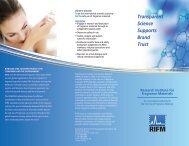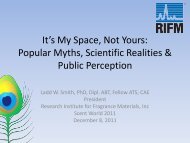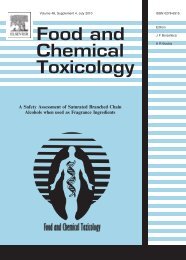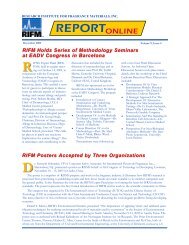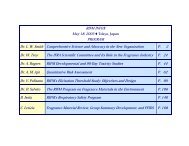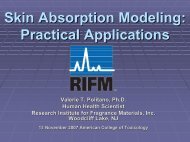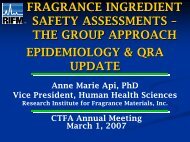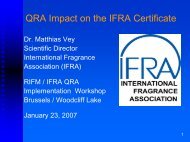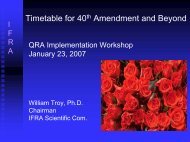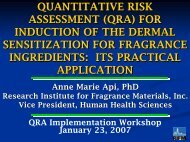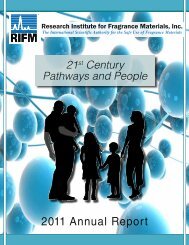Cosmetic Science: Fragrance Safety - Research Institute for ...
Cosmetic Science: Fragrance Safety - Research Institute for ...
Cosmetic Science: Fragrance Safety - Research Institute for ...
Create successful ePaper yourself
Turn your PDF publications into a flip-book with our unique Google optimized e-Paper software.
<strong>Cosmetic</strong> <strong>Science</strong>: <strong>Fragrance</strong> <strong>Safety</strong><br />
Ladd W. Smith, PhD, Dipl ABT, Fellow ATS, CAE<br />
President<br />
7 CTDC, Sun City, South Africa, September 9, 2009
Gestalt … an objective?<br />
… a structure, configuration, or pattern of<br />
physical, biological or psychological<br />
phenomena so integrated as to constitute a<br />
functional unit with properties not derivable<br />
by summation of its parts …<br />
LWS Sept 9 2009
Toxicology is arguably the<br />
oldest scientific discipline, as<br />
the earliest humans had to<br />
recognize which plants were<br />
safe to eat.
Cause-effect relationship<br />
RESPONSE<br />
DOSE<br />
EXPOSURE<br />
SOURCE<br />
LWS Sept 9 2009
The observation …<br />
RESPONSE<br />
DOSE<br />
LWS Sept 9 2009
The question …<br />
RESPONSE<br />
10 -5<br />
10 -6 PPB PPM<br />
DOSE<br />
LWS Sept 9 2009
Population dose-response<br />
Many<br />
Number of Individuals<br />
Resistant<br />
Individuals<br />
Minimal<br />
Effect<br />
Majority of<br />
Individuals<br />
Average Effect<br />
Sensitive<br />
Individuals<br />
Maximal<br />
Effect<br />
Few<br />
Mild<br />
Response to SAME dose<br />
Extreme<br />
LWS Sept 9 2009
“Typical” population<br />
People with “normal”<br />
responses<br />
Less<br />
Sensitive<br />
More<br />
Sensitive<br />
LWS Sept 9 2009
<strong>Fragrance</strong> safety assessment<br />
Database<br />
Priorities<br />
Exposure Assessment<br />
Testing & <strong>Research</strong><br />
Expert Panel <strong>Safety</strong> Assessment<br />
Communications IFRA Standard Publications<br />
LWS Sept 9 2009
Database<br />
OK<br />
LWS Sept 9 2009
IN SUMMARY<br />
RIFM is supporting the fragrance<br />
industry <strong>for</strong> REACH in several ways<br />
RIFM Database is a valuable resource <strong>for</strong><br />
REACH<br />
REACH data requirements are significant<br />
and expensive<br />
Data sharing will be complicated!<br />
LWS Sept 9 2009
IN SUMMARY<br />
RIFM is supporting the fragrance<br />
industry <strong>for</strong> REACH in several ways<br />
RIFM Database is a valuable resource <strong>for</strong><br />
REACH<br />
REACH data requirements are significant<br />
and expensive<br />
Data sharing will be complicated!<br />
LWS Sept 9 2009
Material responsibility<br />
• European/USEPA<br />
Notification<br />
• Internal Evaluation<br />
COMPANY<br />
REACH<br />
COMMERCIALIZATION<br />
RIFM<br />
LWS Sept 9 2009
Published methodology<br />
Human Health Criteria Document –<br />
Reg. Tox. & Pharm., 31, 166-181, 2000<br />
Environmental Framework Document – Env. Tox. &<br />
Chemistry, 21, 1301-1308, 2002<br />
RIFM Expert Panel <strong>Safety</strong> Evaluation Process – Reg.<br />
Tox. & Pharm., 37 (2), 218-273, 2003<br />
Industry Exposure Consideration Practices – Reg. Tox.<br />
& Pharm., 36, 246-252, 2002<br />
LWS Sept 9 2009
The Expert Panel<br />
Jon M. Hanifin, MD<br />
Oregon Health <strong>Science</strong>s Univ.<br />
Portland, OR<br />
I. Glenn Sipes, PhD. (Chair)<br />
University of Arizona<br />
Tucson, AZ<br />
Donald V. Belsito, M.D.<br />
Univ. of Missouri<br />
Kansas City, MO<br />
David R. Bickers, MD<br />
Columbia University<br />
New York, NY<br />
Maria L. Z. Dagli, DVM, PhD<br />
Univ. of Sao Paolo<br />
Sao Paolo, Brazil<br />
Prof. Magnus Bruze<br />
Malmo University Hospital<br />
Malmo, Sweden<br />
Prof. Peter Calow<br />
Roskilde University<br />
Roskilde, Denmark<br />
Prof. Dr. Helmut A. Greim<br />
Neuherberg Institut für Toxikologie<br />
Munich, Germany<br />
Jean-Hilaire Saurat, MD<br />
Universitaire de Geneve<br />
Geneva, Switzerland<br />
LWS Sept 9 2009<br />
Yoshiki Miyachi, MD, PhD<br />
Kyoto Univ.<br />
Kyoto, Japan
Expert Panel adjuncts<br />
LWS Sept 9 2009
Structural group approach<br />
Chemical structure helps to predict<br />
‣ transdermal absorption<br />
‣ metabolism<br />
‣ disposition<br />
‣ functional groups that can influence toxicity<br />
Group safety evaluations can demonstrate that<br />
within a congeneric group similar biochemical fate<br />
and toxicological potential can be exhibited<br />
It is anticipated that the group is efficiently<br />
detoxicated to yield the same or similar metabolites<br />
LWS Sept 9 2009
<strong>Fragrance</strong> Material Review<br />
Peer Publication<br />
IFRA Standard<br />
Dossier, database<br />
Report reviewed by the Expert Panel,<br />
conclusion<br />
Budget (group)<br />
Study sponsored<br />
Group<br />
evaluation<br />
Preliminary<br />
assessment<br />
Expert Panel<br />
data determination<br />
LWS Sept 9 2009
<strong>Fragrance</strong> material dossier<br />
Acute mammalian toxicity (very seldom)<br />
Genetic toxicity – in vitro point mutation, micronucleus<br />
Skin effects – Local Lymph Node Assay, human repeated<br />
insult patch test<br />
90-Day repeated dose toxicity<br />
Skin absorption<br />
Reproduction/developmental<br />
Biodegradation<br />
Acute aquatic toxicity – algae, invertebrate, vertebrate<br />
Chronic aquatic toxicity<br />
LWS Sept 9 2009
Quantitative Risk Assessment (QRA)<br />
Determine potential (hazard) to induce sensitization<br />
‣ Pre-clinical – animals, Local Lymph Node Assay<br />
‣ Historical human data<br />
‣ Structure-based prediction<br />
Dose response<br />
‣ No-Expected-Sensitization-Induction-Level<br />
‣ Weight of Evidence<br />
‣ Sensitization Assessment Factor<br />
Exposure<br />
‣ Expressed in Dose/Area<br />
‣ Consumer use in product categories<br />
‣ Amount, duration and frequency<br />
Risk characterization<br />
‣ Acceptable levels of dermal sensitizers<br />
LWS Sept 9 2009
QRA <strong>for</strong> skin sensitization<br />
Impact on existing IFRA Standard<br />
Cat.<br />
(Product Type)<br />
Cinn. Ald.<br />
Old Method<br />
Cinn. Ald.<br />
QRA Approach<br />
1 Lip Products, Toys 0.05% 0.02%<br />
2 Deodorant/Antiperspirant 0.05% 0.02%<br />
3 Hydroalc - Shaved Skin 0.05% 0.09%<br />
4 Hydroalc - Unshaved Skin 0.05% 0.3%<br />
5 Hand Cream 0.05% 0.1%<br />
6 Mouthwash, Toothpaste NA 0.4%<br />
7 Baby Wipes 0.05% 0.04%<br />
8 Nail Care 0.05% 0.6%<br />
9 Shampoo, Bar Soap 0.05% 3.0%<br />
10 Detergent 0.05% 2.5%<br />
11 Non-skin, Incidental Skin 0.5% Limited<br />
LWS Sept 9 2009
European Epidemiology Study<br />
(Italy, Germany, The Netherlands,<br />
Portugal and Sweden)<br />
2005/2006<br />
PHASE I<br />
VALIDATION<br />
2008-2010<br />
PHASE III<br />
FULL STUDY<br />
2007/2008<br />
PHASE II<br />
PILOT STUDY<br />
Questionnaire<br />
Code Book & Data Entry<br />
Data Collection:<br />
Italy, The Netherlands,<br />
Sweden<br />
Questionnaire<br />
Reproducibility<br />
Patch Test<br />
Procedures<br />
Data Collection:<br />
15,000 Subjects<br />
(2,500 per center)<br />
Statistical Analyses:<br />
Pooled Data<br />
Heidelberg Center<br />
in Collaboration<br />
With Italy group<br />
2011/2012 - North America<br />
2013/2014 LWS Sept 9 2009 - Asia<br />
Definition of<br />
Sampling Procedures &<br />
Subject Recruitment<br />
600 subjects recruited:<br />
(100 per center)<br />
General Population<br />
Statistical Analyses<br />
Study Modalities<br />
Evaluation
Environmental <strong>Science</strong><br />
Environmental<br />
Standards &<br />
Group Testing<br />
Population<br />
Modeling<br />
Roskilde<br />
HESI<br />
Bioaccumulation<br />
Project<br />
REACH<br />
Exposure<br />
Scenarios<br />
Emerging<br />
Chemicals<br />
of Concern<br />
(eg Great Lakes)<br />
ECETOC<br />
Scientific<br />
Committee<br />
SETAC<br />
Advisory<br />
Groups &<br />
UNEP SAICM<br />
OECD<br />
Toolbox<br />
Endocrine Disruption<br />
DfE/Ecolabels<br />
LWS Sept 9 2009
Respiratory <strong>Science</strong><br />
Clinical Inhalation Study<br />
‣ Aerosol exposure, 9 materials, non-, mild, and moderate asthmatics<br />
‣ No increase in airway inflammation or pulmonary function<br />
Inhalation Exposure Assessment Modeling<br />
‣ 2-box air dispersion model based on human habits and practices<br />
In Silico Predictive Inhalation Deposition<br />
‣ Computational Fluid Dynamics and Multiple Particle Path Deposition<br />
‣ Modeling to establish location and assess biological effects<br />
‣ In vivo corroboration and cell type differentiation<br />
In Vitro High Throughput Respiratory Sensitization<br />
‣ Unique 3-cell co-culture mimics lung where most materials interact<br />
with respiratory epithelium and initiate inflammatory signaling<br />
‣ Identify materials as allergenic or non-allergenic with cytokine profiling<br />
?<br />
LWS Sept 9 2009
The plat<strong>for</strong>m<br />
OCCUPATIONAL ENVIRONMENTAL CONSUMER<br />
LWS Sept 9 2009
Formulation additives - effects<br />
Hydration: water, creams, lotions, occlusion<br />
Delipidization: solvents, ionic surfactants<br />
Protein denaturation: solvents, ionic<br />
surfactants<br />
Vasodilation: nicotinates<br />
Enzyme Induction/Inhibition: polyaromatic<br />
hydrocarbons, benzpyrene<br />
LWS Sept 9 2009
Diffusion is favored by:<br />
Large surfaces area <strong>for</strong> transfer<br />
Small molecular weight<br />
Lipid solubility<br />
‣ Low octanol/water coefficient (1 – 4)<br />
‣ Non polar metabolites<br />
‣ Non-ionized state<br />
Good dissolution in membrane environment<br />
Thin membrane<br />
High concentration gradient<br />
LWS Sept 9 2009
Anatomical considerations<br />
Primary barrier to absorption is the stratum<br />
corneum (outer, skin layer)<br />
Dead keratinocytes embedded in a lipid matrix,<br />
through which most materials are absorbed to<br />
some degree<br />
Lipid matrix secreted by cells in lower layers<br />
Basal layer of viable keratinocytes which migrate<br />
to surface and are shed<br />
Dermis (next layer) and vasculature<br />
LWS Sept 9 2009
Body site differences<br />
Rate of penetration and absorption differs<br />
across body sites due to anatomy (skin<br />
thickness, lipid composition) and physiology<br />
(blood flow, distribution of blood vessels,<br />
number of follicles)<br />
Scrotum > Forehead > Axilla >= Scalp > Back<br />
>= Abdomen > Palm and Plantar surfaces<br />
LWS Sept 9 2009
Strategic issues generation<br />
JAG SC<br />
Industry <strong>Science</strong><br />
Community<br />
EFFA<br />
IFRA<br />
FMA<br />
Industry Trade<br />
Associations<br />
Expert Panel<br />
RIFM staff<br />
Independent<br />
<strong>Science</strong> Community<br />
Strategic<br />
Issues<br />
PCPC/Colipa<br />
Consumer Goods<br />
Associations<br />
CSPA<br />
SDA/AISE<br />
RIFM Members<br />
LWS Sept 9 2009
<strong>Research</strong> project prioritization<br />
5<br />
2<br />
3 1<br />
4<br />
6 7 8<br />
11 9 10<br />
12 14 13<br />
15<br />
Impact (high to low)<br />
1. Respiratory dosimetry<br />
2. Respiratory sensitization<br />
3. Epidemiology<br />
4. Elicitation<br />
5. In vitro methodology<br />
6. Group summary methods<br />
7. Group summary biology<br />
8. Group summary ecotoxicity<br />
9. Environ population model<br />
10. Cumulative toxicity<br />
11. Cumulative toxicity<br />
12. Reproduction<br />
13. Reproduction<br />
14. Reproduction<br />
15. Reproduction<br />
(bubble size = funding amount)<br />
LWS Sept 9 2009
LWS Sept 9 2009
National <strong>Research</strong> Council<br />
“Toxicity Testing in the Twenty-first Century:<br />
A Vision and a Strategy,” June 2007<br />
Testing on animals should be greatly reduced<br />
Use of cells, cell lines, cell components<br />
Understanding of how genes, proteins and small molecules<br />
interact <strong>for</strong> normal cell function – cell signaling pathways<br />
Perturbation of cellular and biochemical components to<br />
possibly cause disease<br />
High throughput assays vs. high dose animal tests<br />
Combination and evolution over 10 to 20 years<br />
Testing based on human biology<br />
LWS Sept 9 2009
Ef<strong>for</strong>ts in alternatives<br />
Local Lymph Node Assay & B220 modification – hazard<br />
identification and potency classification<br />
Center <strong>for</strong> Alternatives to Animal Testing, Johns Hopkins University<br />
‣ Gene expression changes<br />
‣ High throughput microfluidics<br />
Theoretical model <strong>for</strong> predicting skin absorption<br />
‣ in vitro (vs. in vivo) RIFM data<br />
MultiCASE <strong>for</strong> assessment of biological activity<br />
International QSAR Foundation chemical allergen project<br />
In vitro/cell methodology <strong>for</strong> respiratory sensitization<br />
ILSI-HESI Project Committee on Improving Bioaccumulation<br />
Assessments – in vitro fish assays<br />
LWS Sept 9 2009
Working together …<br />
Human Health<br />
Respiratory<br />
Environmental<br />
Database<br />
The Expert Panel<br />
REACH<br />
Code of Practice<br />
Standards<br />
Compliance<br />
Committees<br />
Communications<br />
Advocacy<br />
LWS Sept 9 2009
IFRA organization<br />
Europe<br />
EFFA<br />
European Flavor<br />
and <strong>Fragrance</strong><br />
Association<br />
North<br />
America<br />
FMA<br />
<strong>Fragrance</strong> Materials<br />
Association of the US<br />
IFRA<br />
International <strong>Fragrance</strong><br />
Association<br />
JFFMA<br />
Japanese<br />
<strong>Fragrance</strong> &<br />
Flavors<br />
Association<br />
Asia/Pacific<br />
Other National<br />
Associations<br />
(China,<br />
Singapore)<br />
Other Regions<br />
(South America,<br />
Australia, New<br />
Zealand)<br />
National Member<br />
Associations<br />
e.g. Brazil<br />
National<br />
European<br />
Associations<br />
Company<br />
Membership<br />
Company<br />
Membership<br />
Company<br />
Membership<br />
Company<br />
Membership<br />
Company<br />
Membership<br />
LWS Sept 9 2009
<strong>Fragrance</strong> industry stewardship<br />
IFRA Code of Practice<br />
‣ National Association bylaws require adherence<br />
‣ GMP and use guidelines, definitions, labeling claims<br />
‣ Intellectual property<br />
IFRA Standards<br />
‣ About 150 = specifications, prohibitions, restrictions<br />
IFRA Compliance Program<br />
‣ Assurance from member associations<br />
‣ Verification through 3 rd party analysis<br />
‣ Protocols <strong>for</strong> collection of consumer products, sample<br />
preparation, communication of violation, corrective action,<br />
confidential in<strong>for</strong>mation<br />
‣ Two years of no prohibited materials found<br />
LWS Sept 9 2009
IFRA Standards<br />
DOSSIER<br />
EVALUATION<br />
STANDARD<br />
CONSULTATION<br />
FINAL WORDING<br />
COMMUNICATION<br />
RIFM, IFRA SC<br />
REXPAN<br />
IFRA SC<br />
ASSOCIATIONS<br />
CLIENT INDUSTRY<br />
REXPAN<br />
IFRA SECRETARIAT<br />
LWS Sept 9 2009
IFRA Standards<br />
Globally accepted risk management system<br />
Brazilian regulation official adoption 1990<br />
EU <strong>Cosmetic</strong>s Directive (prohibited included, restricted in<br />
discussion process)<br />
Comparable requirement to be asked under ASEAN<br />
<strong>Cosmetic</strong>s Directive<br />
Currently 44 nd Amendment = 150+ Standards<br />
‣ 75 Standards prohibiting the use of certain fragrance<br />
ingredients, including 26 ‘other materials’ banned due to<br />
insufficient data<br />
‣ 65 Standards restricting the use of certain fragrance<br />
ingredients in fragrance compounds<br />
‣ 11 materials with purity criteria<br />
LWS Sept 9 2009
Compliance program<br />
Program started with method development in 2006<br />
In the 3 cycles, 150 products have been analyzed –<br />
2x15 EDT, 15 shampoos, 15 skin creams, 20 powder<br />
detergents and 20 liquid fabric care products - out of<br />
a random selection of several hundred worldwide<br />
market products<br />
In two cycles of analysis, no IFRA prohibited<br />
materials were detected above a level of 0.01%,<br />
which has been established by IFRA as a “noconcern<br />
level” and is generally considered as the<br />
limit of accurate quantification<br />
One product in third cycle being investigated<br />
LWS Sept 9 2009
<strong>Fragrance</strong> product safety<br />
Member<br />
Companies<br />
Code of<br />
Practice<br />
& Standards<br />
I<br />
F<br />
R<br />
A<br />
<strong>Safety</strong><br />
Evaluations<br />
R<br />
I<br />
F<br />
M<br />
<strong>Research</strong> &<br />
Testing<br />
REXPAN<br />
LWS Sept 9 2009
<strong>Safety</strong> in<strong>for</strong>mation<br />
Manufacturer<br />
RIFM<br />
Consumer Company<br />
Supplier<br />
LWS Sept 9 2009



